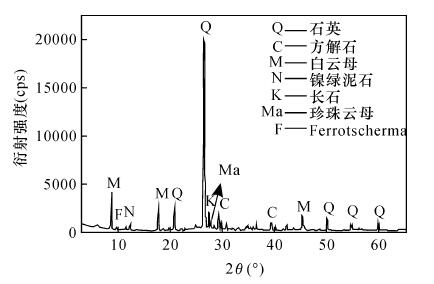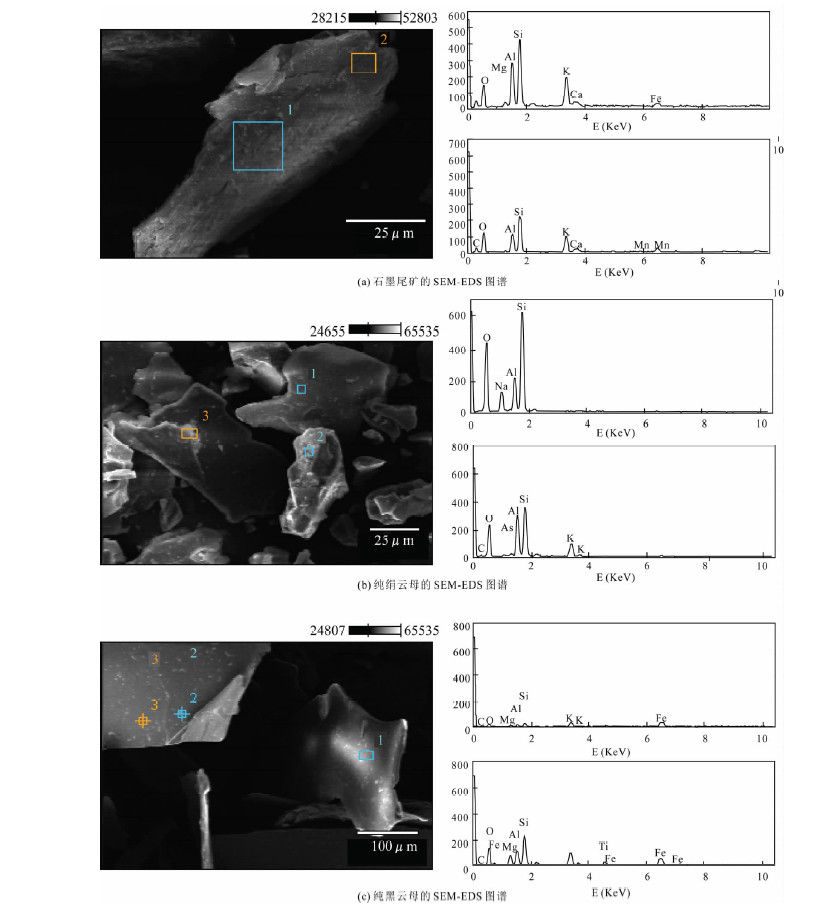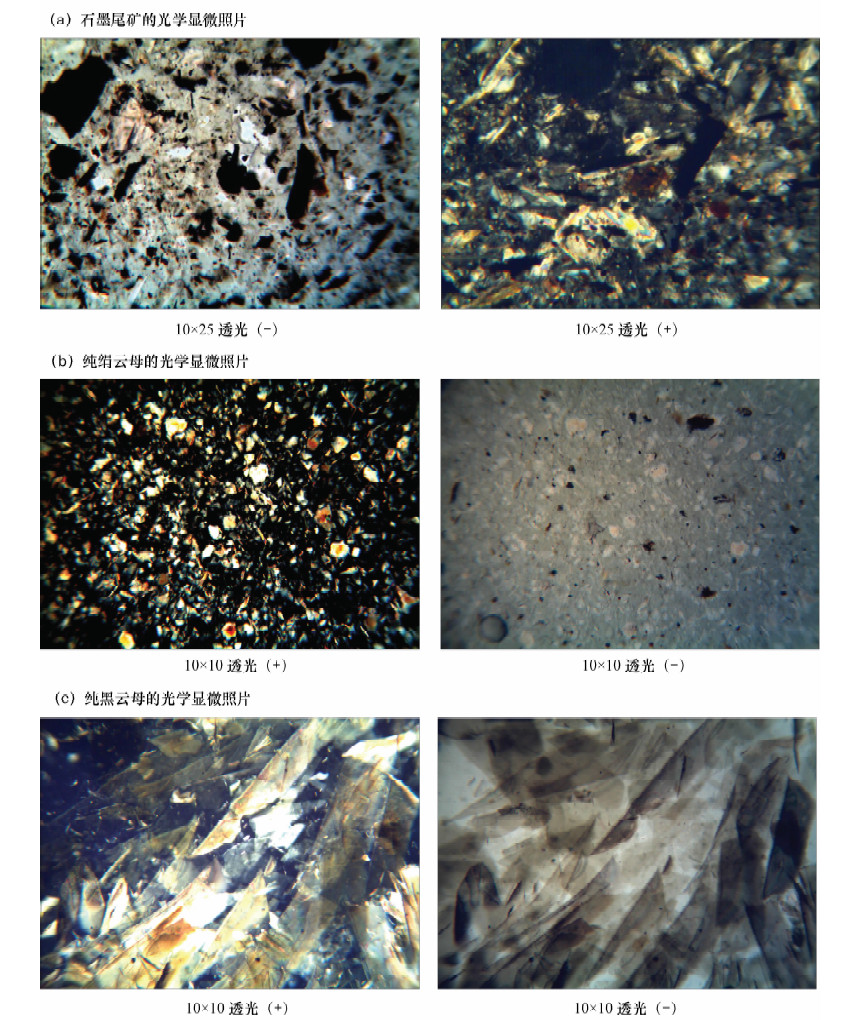Identification of Sericite in Graphite Tailing of Heilongjiang Provice by X-ray Diffraction, Scanning Electron Microscopy and Optical Microscope
-
摘要: 石墨尾矿作为一类二次资源, 当云母类矿物的含量在10%以上时, 具有回收利用价值。黑龙江某地石墨尾矿中含有10%以上的云母类矿物, 但其细度(500~800目)低于常规的云母矿, 本文采用X射线衍射(XRD)分析矿物组成, 再结合化学分析、扫描电镜-能谱、光学显微镜与纯矿物进行对比, 由此鉴定云母类矿物种属。XRD研究初步表明石墨尾矿含有的云母族矿物属于白云母亚类或黑云母亚类。扫描电镜分析表明尾矿中的云母矿物与纯绢云母矿物均以片状和鳞片状为主要存在形态, 而纯黑云母主要以片状形式存在。尾矿的SiO2含量为5%~13%, Al2O3含量为4%~8%, 与纯绢云母接近。光学显微镜鉴定显示在正交偏光下石墨尾矿中的云母颜色和纯绢云母类似, 而与纯黑云母截然不同。综合以上结果最终可确定该地石墨尾矿中的云母族矿物为白云母亚类中的绢云母。本研究为后续石墨尾矿的选矿工艺奠定了基础, 也可应用于类似细度绢云母的鉴定。Abstract: Graphite tailing is a secondary resource, and could be be recovered when the mica mineral content in tailing is higher than 10%. Graphite tailings in Heilongjiang Province contain >10% mica minerals that are 500-800 mesh. These minerals are finer than conventional mica minerals making it difficult to identify its mineral species. In order to resolve this problem, X-ray Diffraction (XRD) was used to analysis mineral composition of the graphite tailing, along with chemical analysis, Scanning Electron Microscopy-Energy-Dispersive Spectrometry (SEM-EDS) and Optical Microscopy. XRD analysis shows that mica minerals can be recovered and chemical analysis indicates that these minerals are possibly muscovite or biotite. Morphology studies indicate that mica minerals in graphite tailing and pure sericite minerals are mainly schistic and scaled, whereas pure biotite is mainly schistic. EDS analysis shows that graphite tailing contains 5%-13% SiO2 and 4%-8% Al2O3. Mica mineral in graphite tailing has color similar to that of pure sericite but different from that of pure biotite, indicated by Optical Microscope. It is concluded that the mica mineral in graphite tailing is sericite of muscovite subtype. This research will provide reliable information for the subsequent mineral processing of graphite tailing and identification of sericite with similar fineness.
-
云母是一种非常重要的非金属矿物材料,具有多种良好的物化性能和电气性能,在电气、塑料、橡胶、造纸、建筑等多个行业中有得到广泛应用[1, 2, 3, 4, 5, 6]。矿物学中云母包括白云母、黑云母和锂云母3个亚类,白云母亚类包括白云母和较少见的钠云母[7],黑云母亚类主要有黑云母和金云母,工业上常用的为白云母和金云母。绢云母是一种微细粒的白云母,具有一些特殊性能,如对紫外线的屏蔽功能更好、具有较高的纵横比等,使得绢云母在某些领域比白云母具有更好的应用性能[8, 9]。
目前我国平均生产1吨石墨精矿需要开采10%品位的石墨矿石20吨,按照我国年产15万吨石墨计算,年排放尾矿达到250万吨以上[10]。由于石墨尾矿中常含有云母等可回收的有用矿物,因此从废弃的石墨尾矿中对其进行回收利用,是我国石墨尾矿资源化的主要途径之一[11, 12, 13],而在伴生的云母类矿物中,绢云母的颗粒较细,易被忽视或误认。鉴于绢云母鉴定的伴生矿物(如石英、黏土类矿物、长石)不同,采用不同的矿物鉴定技术[14, 15, 16, 17]或各种技术的组合[18, 19, 20],如采用X射线衍射(XRD)、差热分析和扫描电镜(SEM)可鉴别绢云母和黏土矿物[21],采用电子探针、XRD和差热热重分析方法可鉴别钾质白云母的种属[22],采用电子探针、XRD、差热热重分析、红外光谱分析方法可鉴定绢云母和水云母[18]等。
本次研究的黑龙江某地石墨尾矿,粒度细(粒度小于30μm的占69%),其中云母族矿物的粒度在800目左右,且部分与长石等脉石连生,为了在后续的选别作业中更好地解决该云母族矿物与其他脉石矿物的分离问题,需要确定云母的种类,因此,首先采用XRD初步确定该类尾矿中的有用矿物为云母族矿物,然后通过扫描电镜(SEM)、能谱分析(EDS)将其与标准纯矿物进行了形貌、微区成分对比,再运用光学显微镜研究对比了该云母族矿物与标准绢云母纯矿物的光学性质,从而最终确定该石墨尾矿中的云母族矿物所属哪一种亚类。
1. 实验部分
1.1 石墨尾矿原矿的性质和化学成分分析
原矿样品采自黑龙江某地石墨尾矿,肉眼观察其颜色为土状,土(黄)色,可见部分微细粒的片状矿物,通过样品粒度测试分析,原矿粒径分布范围为0.375~300 μm,体积平均粒径44.31 μm。焙烧法测得其中固定碳含量为2.5%。化学成分分析获得各组分的含量(%)分别为:SiO2 53.60,Al2O3 15.29,Fe2O3 8.74,TiO20.79,CaO 10.81,K2O 4.65,MgO 2.75,SO3 2.13,Na2O 0.47,P2O5 0.28。
1.2 绢云母矿物的鉴定分析
X射线衍射分析:研究石墨尾矿原矿样品的主要物相。由于样品细度满足X射线分析的要求,因此将样品直接置于样品槽中,采用背压法制备X射线衍射测试试样。测试条件为:Rigaka-RA高功率旋转阳极12 kW X射线衍射仪,Cu靶,电压40 kV,电流100 mA。
扫描电镜分析:确定石墨尾矿中各种矿物的形貌。将原矿样品经过超声波分散处理后,均匀地撒在双面胶上,经喷金处理制成扫描电镜观察的试样,采用S-4800型扫描电镜显微镜能谱测试。
光学显微镜分析:利用矿物镜下属性不同,在光学显微镜下观察,是鉴别矿物最有效和最基本的方法之一。将试验所得全部样品均匀缩分后,取代表性样品磨制光薄片,采用PM6000光学显微镜观察。
2. 结果与讨论
2.1 X射线衍射分析
石墨尾矿的X射线粉晶衍射分析结果见图 1。将其中云母的3条主峰与标准白云母的主峰对比,FOM(吻合程度参数)合理,因此,通过XRD分析初步认为石墨尾矿中的云母属于云母族中的白云母亚类。
为了进一步研究石墨尾矿中的云母是否为白云母,而且该尾矿中蚀变和风化并不严重,可以应用SEM结合EDS和光学显微镜来鉴别矿物种类和估计含量[15]。本研究利用这3种技术从形貌、微区成分和光学显微镜下光学性质等方面,将样品与白云母标准样品(-200目100%,纯度90%以上,由于细粒的白云母即为纯绢云母,所以以下称之为纯绢云母)和纯黑云母(-200目20%,纯度90%以上)进行比较分析。
2.2 扫描电镜形貌分析
应用SEM对石墨尾矿中的云母和纯绢云母进行了大量的形貌分析,其中代表性图像见图 2。图 2a的绢云母主要呈鳞片状、片状(长径比较小)或层状、少量呈针状形式存在。长石主要为粒状。在长石颗粒表面还粘有细小的云母颗粒。图 2b的纯绢云母矿样中,颗粒主要以鳞片状和片状性态存在。与石墨尾矿中的云母相比,其长径比稍大一些,片状白云母的含量要稍多些,这主要是因为石墨尾矿的粒度比白云母标准矿样要小得多。可见,石墨尾矿中的云母与纯绢云母矿物都是以片状和鳞片状为主要存在形态,而且二者的存在形态类似;而黑云母(图 2c)主要以片状形式存在,而且长径比要比石墨尾矿中的云母大得多。因此,不能从形貌方面简单地认为石墨尾矿中的云母就是绢云母。
2.3 能谱微区成分分析
将石墨尾矿中的云母、纯绢云母、黑云母分别进行微区成分分析,在大量取点的基础上进行分析判断,其中代表性图像如图 3所示,代表性数据见表 1。
对比大量的石墨尾矿中云母、纯绢云母、纯黑云母的SEM-EDS图谱及微区成分,可以得出石墨尾矿中的Al2O3在云母中的含量为4%~8%,在纯绢云母中的含量为8%~10%,而在纯黑云母中的含量为2%~4%,同时石墨尾矿中SiO2在云母中的含量为5%~13%,在纯绢云母中的含量为13%~24%,而在纯黑云母中的含量为3%~9%。通过Al2O3和SiO2两个组分的比较可看出,石墨尾矿中的云母与纯绢云母更为接近,而石墨尾矿中Al2O3和SiO2含量比纯绢云母较低的原因是因为石墨尾矿中还含有其他硅酸盐矿物。
表 1 石墨尾矿、纯绢云母、纯黑云母的SEM-EDS图像(图 3) 中对应点位的成分Table 1. Compositions of points in SEM-EDS micrographs of graphite tailing (Fig.3a), pure sericite (Fig.3b) and pure biotite (Fig.3c)图 3a对应
的点位元素含量(%) C O Mg Al Si K Ca Mn Fe pt1 32.09 36.10 0.78 7.80 12.41 7.84 1.10 - 1.89 pt2 40.06 40.06 - 4.11 8.58 5.28 1.44 0.48 - 图 3b对应的
点位C O Na Al Si K Fe As pt2 - 57.63 10.19 8.04 24.14 - - - pt3 19.13 52.84 - 10.20 13.06 4.76 - 0.00 图 3c对应的
点位C O Mg Al Si K Ti Fe pt1 40.53 24.79 2.73 2.04 3.04 6.45 - 20.42 pt2 21.42 41.37 4.17 4.91 9.96 5.59 1.34 11.23 2.4 光学显微镜分析
针对以上分析中并不能准确地确定石墨尾矿中的云母为何种云母,为了进一步鉴别该种矿物,采用光学显微镜分别对石墨尾矿、纯绢云母、纯黑云母进行镜下性质分析研究,代表性图像见图 4。
图 4a为石墨尾矿的光学显微镜照片。可以看出,石墨尾矿中的云母在单偏光下为无色透明,微带浅褐色,正交偏光下,其颜色艳丽,为二级蓝。多呈片状或鳞片状。
图 4b为纯绢云母的光学显微镜照片。可以看出,绢云母在单偏光下为无色透明,微带浅褐色,正交偏光下,其颜色艳丽,为二级蓝。多呈片状或鳞片状。将石墨尾矿中云母的光学性质与纯绢云母的光学性质对比,二者在单偏光、正交偏光下颜色大体一致。石墨尾矿中的云母在正交偏光镜下,呈绚丽的丝绢光泽,这也与王巧玲等[23]在千枚岩中观察到的绢云母一致。
图 4c为纯黑云母的光学显微镜照片。可以看出,纯黑云母在单偏光下为无色至褐黄色,与石墨尾矿中的云母和纯绢云母类似,但是在正交偏光下,其颜色为褐黄色至深褐色,这与石墨尾矿中的云母和纯绢云母不同,因此可以判断石墨尾矿中的云母不是黑云母。
3. 石墨尾矿中云母族矿物鉴定特征
X射线衍射分析表明,石墨尾矿中存在云母族矿物,结合原矿化学成分分析,认为该云母族矿物不属于锂云母。形貌上,石墨尾矿中的云母与纯绢云母矿物都是以片状和鳞片状为主要存在形态,二者存在形态类似,而黑云母主要以片状形式存在,在成分上,石墨尾矿中云母的主要成分(SiO2、Al2O3)均比纯黑云母中的高,而与纯绢云母中相应的成分更为接近。
石墨尾矿中的云母在单偏光下为无色透明,微带浅褐色,正交偏光下,其颜色艳丽,与纯绢云母矿物类似,而纯黑云母矿物虽然在单偏光下为无色至褐黄色,与石墨尾矿中的云母和纯绢云母类似,但在正交偏光下,其颜色为褐黄色至深褐色。
由以上石墨尾矿中云母族矿物的鉴定特征可知,该矿物为绢云母,而传统的绢云母选矿,一般可采用单一正浮选[11, 12, 23, 24, 25, 26, 27, 28],或者结合脉石矿物性质采用其他流程进行除杂提纯[29, 30, 31]。
4. 结语
本文对黑龙江某地的石墨尾矿中云母类矿物采用多种现代和传统分析技术进行鉴定, 通过化学成分分析、X射线衍射分析、扫描电镜和光学显微镜镜下观察,确定该地的石墨尾矿的主要化学成分为SiO2、Al2O3、CaO和MgO等,其中的云母族矿物为绢云母。由于绢云母和黑云母是采用不同的选别方法进行选别,本研究为后续选别工艺流程的制定和选别后产品的应用研究奠定了可靠的基础。本研究所利用的多种鉴定技术组合,可对细度在800目以上的绢云母进行鉴定研究;对于细度在800目以下的绢云母,可再结合电子探针和X射线粉晶衍射半定量分析进行鉴定。
-
表 1 石墨尾矿、纯绢云母、纯黑云母的SEM-EDS图像(图 3) 中对应点位的成分
Table 1 Compositions of points in SEM-EDS micrographs of graphite tailing (Fig.3a), pure sericite (Fig.3b) and pure biotite (Fig.3c)
图 3a对应
的点位元素含量(%) C O Mg Al Si K Ca Mn Fe pt1 32.09 36.10 0.78 7.80 12.41 7.84 1.10 - 1.89 pt2 40.06 40.06 - 4.11 8.58 5.28 1.44 0.48 - 图 3b对应的
点位C O Na Al Si K Fe As pt2 - 57.63 10.19 8.04 24.14 - - - pt3 19.13 52.84 - 10.20 13.06 4.76 - 0.00 图 3c对应的
点位C O Mg Al Si K Ti Fe pt1 40.53 24.79 2.73 2.04 3.04 6.45 - 20.42 pt2 21.42 41.37 4.17 4.91 9.96 5.59 1.34 11.23 -
-
期刊类型引用(5)
1. 牛斯达,李胜荣,郭健. 内蒙古甲乌拉铅锌银矿绢云母~(40)Ar-~(39)Ar年龄及其地质意义. 地质与勘探. 2020(01): 59-67 .  百度学术
百度学术
2. 刘海深,许绍彬,罗大芳,肖兴邦,王利明. 白泡石的矿物组成和化学元素分布规律研究. 玻璃纤维. 2020(04): 18-23 .  百度学术
百度学术
3. 张家宏,单永东,李建喜. 钠基低温陶瓷的制备及其在陶瓷化聚烯烃中的应用. 绝缘材料. 2017(07): 11-15 .  百度学术
百度学术
4. 叶美芳,刘三,解古巍,赵慧博,周宁超,魏小燕,杨建国,侯弘,王磊,王轶. 应用扫描电镜-X射线衍射-电子探针研究北山斑岩铜矿区绢英岩中白色云母的特征. 岩矿测试. 2016(02): 166-177 .  本站查看
本站查看
5. 胡勇平,于学峰,郑林伟,郑遗凡. 高分辨扫描电镜和X射线能谱Mapping技术研究碲矿物的成分和形态特征. 岩矿测试. 2015(06): 643-651 .  本站查看
本站查看
其他类型引用(3)




 下载:
下载:



 京公网安备 11010202008159号
京公网安备 11010202008159号